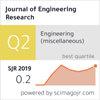Spatial distribution of soil erodibility factors in erosion-prone areas in Umuahia, Southeast, Nigeria
IF 2.2
4区 工程技术
Q3 ENGINEERING, MULTIDISCIPLINARY
引用次数: 0
Abstract
This study evaluates the spatial distribution of soil erodibility factor (K) in Umuahia, Abia State, Nigeria using the Universal Soil Loss Equation (USLE) nomograph. The soils used for the study was sampled from 14 erosion prone areas in Umuahia, Southeast, Nigeria. The topsoil samples collected at depths of 0–10 cm, 10–20 cm, and 20–30 cm around the middle of each location identified with the aid of a GPS. The percentages of sand, silt, clay, moisture content, saturated hydraulic conductivity, and organic matter (OM) were all examined. The Gaussian ordinary kriging model for the determination of K-factor was compared with the Inverse Distance Weighting method. The K-factor’s coefficient of variation (CV) was 0.29 and the K-factor value of the nuggets to sill ratio (0.44) indicates a moderate spatial distribution. The Gaussian semi-variogram approach yielded the best estimate accuracy and model fitting effects, meaning that the Gaussian ordinary Kriging model is better for K-factor estimation. The root mean squared error (RMSE) was 0.0079 and the mean squared deviation ratio (MSDR) was 0.89, implying that the Gaussian model was unbiased and adequately captured the experimental variation. The K-factor values were lower in the north of the research region ranging from 0.0250 to 0.0197 Mg h MJ−1 mm−1 compared to east with the K-factor ranging from 0.0399 to 0.0423 Mg h MJ−1 mm−1. The estimated K-factor was relatively unbiased since the root mean square error was extremely small and the mean error was nearly equal to 0. The determination of soil erodibility (k-factor) influenced by factors such as soil texture, structure, and organic matter is crucial in assessing the vulnerability of land area to soil erosion. The spatial distribution of these factors affects the k-factor at different locations in a landscape, which enables accurate estimation of k-factor. Nutrient levels impact soil erodibility and distribution. Low nitrogen limits growth, favoring erosion. Phosphorus aids stability. Optimal potassium benefits growth and erosion control. Spatial distribution is vital, emphasizing precise nutrient management for effective soil health.
尼日利亚东南部乌穆阿希亚易受侵蚀地区土壤易侵蚀因素的空间分布
利用通用土壤流失方程(USLE) nomograph对尼日利亚阿比亚州乌穆阿希亚土壤可蚀性因子(K)的空间分布进行了评价。用于研究的土壤是从尼日利亚东南部乌穆阿希亚的14个侵蚀易发地区取样的。表土样品采集深度为0-10 cm, 10-20 cm和20-30 cm,每个位置的中间位置通过GPS识别。测试了砂、粉、粘土的百分比、含水量、饱和水力导电性和有机质(OM)。将确定k因子的高斯普通克里格模型与反距离加权法进行了比较。k因子变异系数(CV)为0.29,鸡块与地基的k因子值为0.44,空间分布较为均匀。高斯半变异函数方法的估计精度和模型拟合效果最好,这意味着高斯普通克里格模型更适合k因子估计。均方根误差(RMSE)为0.0079,均方偏差比(MSDR)为0.89,表明高斯模型是无偏的,充分捕捉了实验变化。研究区北部的k因子值为0.0250 ~ 0.0197 Mg h MJ−1 mm−1,东部的k因子值为0.0399 ~ 0.0423 Mg h MJ−1 mm−1。估计的k因子是相对无偏的,因为均方根误差非常小,平均误差几乎等于0。确定受土壤质地、结构、有机质等因素影响的土壤可蚀性因子(k因子)是评估土壤侵蚀脆弱性的关键。这些因子的空间分布影响着景观中不同位置的k因子,从而使k因子的估算更加准确。养分水平影响土壤的可蚀性和分布。低氮限制生长,有利于侵蚀。磷有助于稳定性。最佳钾有利于生长和侵蚀控制。空间分布是至关重要的,强调精确的养分管理,有效的土壤健康。
本文章由计算机程序翻译,如有差异,请以英文原文为准。
求助全文
约1分钟内获得全文
求助全文
来源期刊

Journal of Engineering Research
ENGINEERING, MULTIDISCIPLINARY-
CiteScore
1.60
自引率
10.00%
发文量
181
审稿时长
20 weeks
期刊介绍:
Journal of Engineering Research (JER) is a international, peer reviewed journal which publishes full length original research papers, reviews, case studies related to all areas of Engineering such as: Civil, Mechanical, Industrial, Electrical, Computer, Chemical, Petroleum, Aerospace, Architectural, Biomedical, Coastal, Environmental, Marine & Ocean, Metallurgical & Materials, software, Surveying, Systems and Manufacturing Engineering. In particular, JER focuses on innovative approaches and methods that contribute to solving the environmental and manufacturing problems, which exist primarily in the Arabian Gulf region and the Middle East countries. Kuwait University used to publish the Journal "Kuwait Journal of Science and Engineering" (ISSN: 1024-8684), which included Science and Engineering articles since 1974. In 2011 the decision was taken to split KJSE into two independent Journals - "Journal of Engineering Research "(JER) and "Kuwait Journal of Science" (KJS).
 求助内容:
求助内容: 应助结果提醒方式:
应助结果提醒方式:


